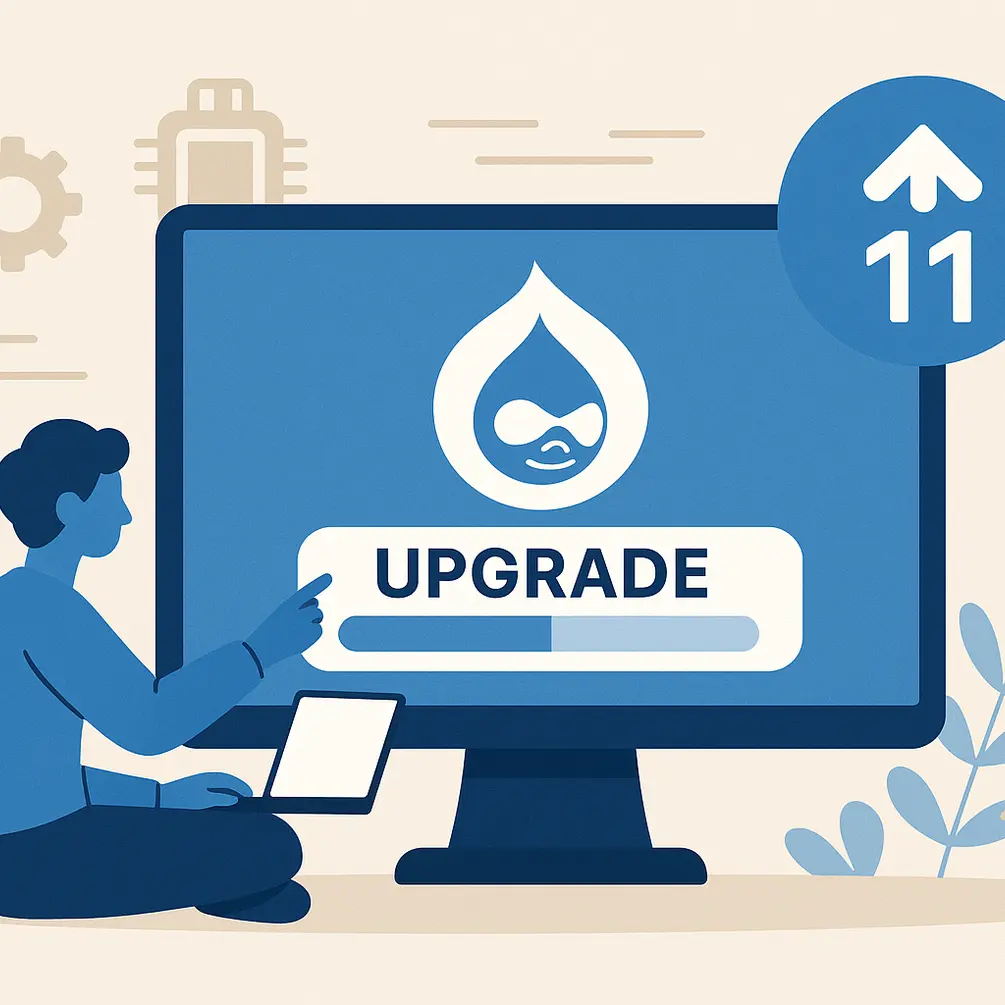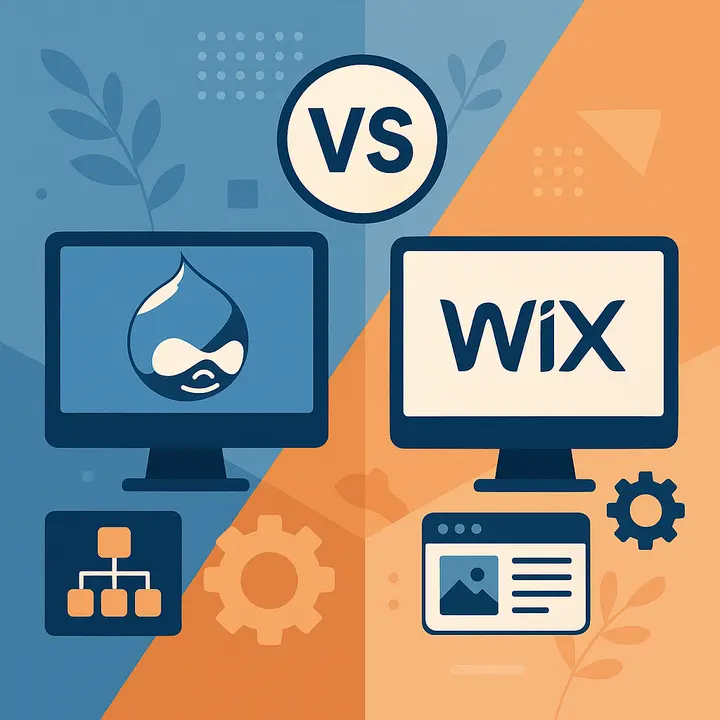With Drupal 11 officially released, now is the time to plan your upgrade strategy. Whether you're moving from Drupal 10 site or finally making the leap from Drupal 7, this extensive guide from the Drupfan team covers everything you need to know to ensure a seamless transition.
The Ultimate Drupal 11 Upgrade Guide: Essential Steps for a Smooth Transition

How to prepare for upgrade from Drupal 10 (with modules)?
Start by auditing your current Drupal site. What modules are installed? Which ones are custom? Are all third-party libraries still supported? These details shape your upgrade path. Reviewing performance bottlenecks ahead gives you a chance to implement technical enhancements that improve speed and responsiveness.
- Run Upgrade Status
Install the Upgrade Status module to identify deprecated APIs, contrib compatibility, and environment readiness. This tool scans your site to detect deprecated code, incompatible modules, and environment issues, giving you a clear picture of what needs fixing before upgrading to D11.
- Audit modules and themes
Use composer show to list all installed packages. Group them by:
- Core
- Contrib
- Custom
Flag features that haven’t had a recent release or are marked as unsupported. Categorizing your codebase helps identify what needs updates, replacements, or rewrites to ensure 11 version of Drupal compatibility. Run composer outdated to see what need updates. Use composer update to bring everything up to the latest supported versions before attempting the transition.
- Review custom code
Tools like Drupal Rector help automate the removal of legacy APIs in custom modules, saving hours of manual refactoring and reducing upgrade errors. Run drupal-check or PHPStan to identify outdated hooks, APIs, or base classes. Watch for removed services in Drupal version 11.
- Evaluate content and configuration
Inventory:
- Paragraph bundles
- Field types
- Media usage
- Entity references
Clean up unused bundles and consolidate where possible. Mapping out content types, fields, and relationships prevents data loss and ensures smooth migration of structured content and configurations into the new environment.
- Check performance bottlenecks
Profile database queries, check cron tasks, and review caching strategies (Twig, Render, Dynamic Page Cache). Identifying slow queries, cron issues, or inefficient caching before the upgrade helps optimize your site and avoid carrying over performance issues.
- Back up your environment
Export config (drush cex), dump the DB, and archive the full codebase. Test restoring locally before upgrading. Backups safeguard your data and configuration, allowing you to restore the site quickly if the upgrade process fails or introduces critical issues.
You’re laying the foundation here. Skipping prep leads to bugs, downtime, and failures.
Why upgrade to Drupal 11 major release now?
Waiting increases risk, amount of legacy code, and technical debt. New Drupal 11 brings updated dependencies and streamlined APIs. If you’re on Drupal 10.3, the upgrade is incremental. If you're looking for Drupal 7 migration, the gap is huge but fixable.
Key benefits of 11 version of Drupal
- Modern stack support: PHP 8.3, Symfony 6, content editor 5. Everything is faster, more secure, and better maintained.
- Cleaner APIs: Expect cleaner integrations and fewer edge-case bugs.
- Improved developer experience (DX), digital experiences, and user experience (UX): It streamlines backend workflows with features like dependency injection, typed data, and autoloading, while also delivering faster interfaces and cleaner editing tools for content teams and end users.
- Ongoing support: Community focus shifts fast. The longer you stay on older versions, the harder it gets to find support.
- New features: streamlined APIs, improved configuration workflows, better media handling, and enhanced support for modern development practices make it faster, cleaner, and more maintainable.
- Single directory components: A new frontend theming approach that lets you group templates, styles, and scripts in one folder per component for cleaner, modular design.
- Site builder-friendly: With tools like Layout Builder and improved config management, site builders make Drupal scalable without writing custom programming.
Drupal 11 vs. Drupal 10: Key differences and what's new
Drupal 11 vs. Drupal 7: Key Differences, features and improvements
When should you conduct Drupal 10 to 11 update process?
Drupal Core 10 will reach end-of-life mid-late 2026 (according to drupal.org), when Drupal 12 is released. That’s why website owners should start planning their Drupal 11 upgrade now to avoid last-minute technical debt, reduce risks, and stay on a supported, secure platform. You should conduct an update to Drupal 11 a s soon as your entities are Drupal 11-ready. Most contrib features are actively maintained and release patches quickly. If your site runs clean on Drupal 10.2+, the jump to 11 will likely be smooth.
Tip: Use the Upgrade Status to check compatibility. Don’t wait for EOL to panic.
When should you conduct Drupal 7 to Drupal 11 migration?
The answer is now. Drupal 7 has already reached its end of life, meaning it no longer receives security updates or Drupal community support, leaving your site vulnerable, outdated, and increasingly expensive to maintain. Site migrations from 7 aren’t updates (like 10 to 11), they’re full rebuilds. Drupal core modules and themes, even content types: nothing maps 1:1. New website architecture needs to be created from scratch.
Give yourself at least 3–6 months lead time for:
- Content mapping
- Custom module redevelopment
- Retesting everything, end-to-end
If your site is critical to your business, don’t leave it for Q4 2025.
→ Read more: Future-Proof Your Website: Migrating from Drupal 7 to Drupal 11
Drupal 11 Upgrade Plan
A structured plan reduces risk and costs. Here’s how Drupfan approaches it for our clients.
Mapping content migration
- Identify all content types, fields, and taxonomies.
- Remove outdated content and unused structures.
- Plan transformations if structures will change.
Documentation is key here. Know what you’re moving, where it’s going, and how you’ll test it.
Performing a site transition
- Set up a clean Drupal 11 environment.
- Port or rebuild your theme.
- Rebuild views and blocks if needed.
- Move configuration and data in stages.
- Run regression testing across critical paths.
Don't skip QA. Test mobile responsiveness, forms, search, and integrations. Then test again.
Key thing to consider when upgrading a website from Drupal 10 to Drupal 11
- Custom code: What you wrote in 2015 might not work in 2025. Audit it, rewrite it, or retire it.
- SEO impact: Maintain URL structures, metadata, and redirects. Use Redirect and Pathauto early.
- Hosting: Confirm that your hosting supports PHP 8.3+ and Drupal 11’s system requirements.
- Editor workflows: If you're switching to content editor 5, retrain content teams ahead of time.
- Contrib readiness: Confirm that key functionalities (e.g., Webform, Paragraphs, Commerce) are 11-ready or find alternatives.
The way you use Drupal, whether as a full-blown CMS, a headless backend, or a flexible low-code platform, should guide your migration project priorities. The latest major release is always easier to maintain, more secure, and offers exciting new features.
→ Read more info on things to consider during the Drupal upgrade process in our latest blog post.
Upgrade to Drupal latest version now
Want your Drupal Content Management System upgrade handled by people who’ve done this before? Drupfan Dupal developers and site builders don’t guess. We plan, transfer, and launch without breaking your business. Request a free migration assessment now.




